12/10/19
Clas Ohlson: Railway combined with shipping is outstanding
APM Terminals spoke to Peter Bergestål, Head of Transport at Clas Ohlson, to find out how they view the future of container transport, climate-efficient transport and the trends in Swedish logistics.
Peter Bergestål has worked with logistics at Clas Ohlson for seven years and has long experience in transport and logistics. In an interview with APM Terminals, he talks about how Clas Ohlson has steered his flow to shipping and rail, and how important it is with faster and more environmentally friendly sea transport.
What are the most important trends in logistics?
- We see a huge focus on the environment and more environmentally friendly transport. We talk a lot about oncoming transport and seafreight with a focus on the environment. In other areas of logistics and transport, there is also a huge focus on Last Mile Distribution and fast and predictable deliveries to end customers.
How does Clas Ohlson want Sweden's freight transport to develop in the coming years?
- I want to summarize it as environment, environment and again environment. In my role at Clas Ohlson, I think that it is a pity that we do not have a railway structure that allows more rail transport. Currently, the train is the only sensible alternative to transporting goods.
Do you think the transport customer is getting enough information about the flow of goods today?
- Yes, I think so. It has never been as good as it is now. We use freight forwarders who buy shipments from the shipping company. Digitization began several years ago and I now have full control over where our goods are and when it is expected to come to Insjön. When delays are encountered on the seas or in ports, we get that information, so there are no major problems.
How important are transport times? Will it be even more important with short transport times in the future?
- Yes, it will. Should any company succeed in developing faster and more environmentally friendly maritime transport, the entire market would choose them. It is not good that nowadays it takes 45-50 days from door to door, from shipping in Asia until we have the goods in Insjön. Had that time been more like 30 days, which it was when it was at its best 10-15 years ago, it would have been fantastic. But it must not be at the expense of the environment.
Is it too easy to order truck transports today? Why don't more goods go by rail or shipping?
- The problem is the lead times. Once the goods have arrived at the border, you want them home as soon as possible. We at Clas Ohlson sit on the gold seat because we use one of the rail shuttles that goes from Gothenburg port all the way up to Insjön. We have used it for several years, but before that it was the truck that applied. We have controlled our entire flow, we do not drive a single truck from Gothenburg to Insjön.
How do you view shipping as a type of transport?
- Our flow from Asia is very effective. There is no other type of transport that is just as sensible and cost-effective. We fly some, but only when it is very urgent. If you are going to trade goods from Asia to where we are, shipping is outstanding.
Which collaborations do you see will be needed in the future?
- It's really the parts that exist today. If you look at our freight flow, it is a collaboration between freight forwarder, shipping company, ports/terminals and in our case railway company.
